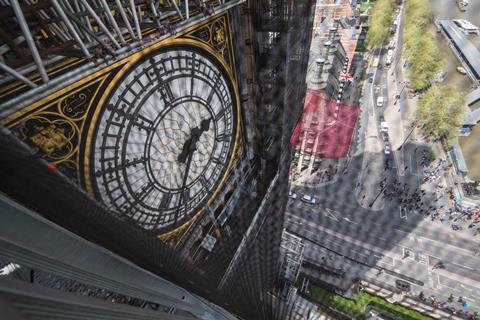- News

All the latest updates on building safety reformRegulations latest
- Focus
- Home
- News
- Focus
- Comment
- Events
- CPD
- Building the Future
- Jobs
- Data
- Subscribe
- Building Boardroom
Elizabeth Tower: The test of time
By Thomas Lane2018-05-18T06:00:00

The Elizabeth Tower is known the world over for housing the bongs of the Big Ben bell, and standing as a symbol of London, the UK and even democracy. But this venerable structure is in dire need of repair – something a five-year, £61m refurbishment programme is taking care of

The clock face on the east side continues working; this will be switched to the north once restored. It features replica hands and is powered by an electric motor
It is rare to find a construction job that produces such an enormous sense of pride among the project team. The team working on the renovation of the Elizabeth Tower, the building popularly known as Big Ben, universally kick off a conversation about the project by saying what an honour it is to work on such an internationally famous architectural icon. “It’s the most iconic building in the world for me,” enthuses Nick Sturge, project manager for the special projects arm of contractor Sir Robert McAlpine, by way of example. “It’s such a privilege to be able to call this my office. When you talk about this job with friends and family they are really interested – usually when I talk about work their eyes glaze over.”
The Elizabeth Tower is one of London’s most instantly recognizable icons and is one of the top 10 most Instagrammed places in the world. Completed in 1854, the 96m high, neo-gothic tower is the work of architect Charles Barry who added a clock tower to his final designs for the Palace of Westminster reconstruction after it burnt down in 1834.
“We’ve tried everything to keep the water out – buckets, mainly”
Adam Watrobski, principal architect, Houses of Parliament
The grade I-listed tower is into the second year of a £61m refurbishment. The work includes conserving and restoring the stonework, cast iron roof, the clock and clock faces. New services are being installed including fire alarms and a lift. Historically, the building has needed attention about every 30 years, with the last major refurbishment taking place in 1983–85, but this latest one is significant as it is the precursor to the wider restoration and renewal of the Palace of Westminster, which is set to start after the work completes on Elizabeth Tower in 2021.
“The clock has enormous international importance and is a symbol of our democracy. It is important that it is working during the renovation and renewal of the Palace of Westminster,” explains Adam Watrobski, the principal architect for the Houses of Parliament. “It also needed doing.” Restoring such a sensitive, historic building is always going to be challenging but this is one of the nations most treasured which inevitably puts added pressure on the project team.
Already registered? Login here
To continue enjoying Building.co.uk, sign up for free guest access
Existing subscriber? LOGIN
Stay at the forefront of thought leadership with news and analysis from award-winning journalists. Enjoy company features, CEO interviews, architectural reviews, technical project know-how and the latest innovations.
- Limited access to building.co.uk
- Breaking industry news as it happens
- Breaking, daily and weekly e-newsletters
Get your free guest access SIGN UP TODAY

Subscribe now for unlimited access
Subscribe to Building today and you will benefit from:
- Unlimited access to all stories including expert analysis and comment from industry leaders
- Our league tables, cost models and economics data
- Our online archive of over 10,000 articles
- Building magazine digital editions
- Building magazine print editions
- Printed/digital supplements
Subscribe now for unlimited access.
View our subscription options and join our community


















